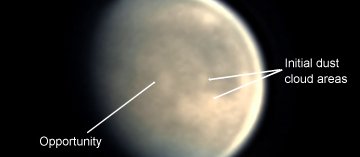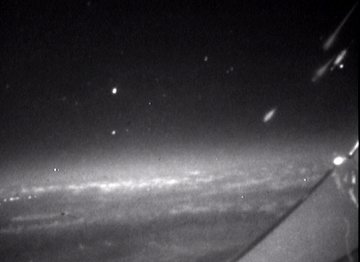 Where's Saturn? Is that a UFO--or the ISS? What's the name of that star? Get the answers from mySKY--a fun new astronomy helper from Meade. . Where's Saturn? Is that a UFO--or the ISS? What's the name of that star? Get the answers from mySKY--a fun new astronomy helper from Meade. . SATURDAY MORNING: Mark your calendar and set your alarm. On Saturday morning, Sept. 8th, "morning star" Venus reaches its greatest brilliancy of the year as the slender crescent Moon glides by--a beautiful ensemble! Look east just before sunrise: sky map. MARTIAN DUST STORMS: The vast and angry dust storms that have been raging around Mars since late June are subsiding, and as the air clears the surface of Mars is showing through once again. "Meridiani Planum, where Mars rover Opportunity is located, is finally visible," reports Jim Melka who took this picture on Aug. 31st using his 12-inch telescope in Chesterfield, Missouri. 
"The bright dust cloud that's been overhead for over a month has greatly diminished," he says. "However, dust clouds are still being produced where it all started at the eastern end of Valles Marineris--see the arrows. Fierce winds in this canyon are probably uplifting the dust. These clouds could expand again to threaten Opportunity." Amateur astronomers can monitor the situation. Mars rises in the east at midnight, bright and red, and its dust clouds are visible in backyard telescopes: sky map. more images: from Ralf Vandebergh of the Netherlands METEOR OUTBURST: "What an adventure!" says astrophotographer George Varros who spent last Saturday morning flying 45,000 ft above the California Coast during the Aurigid meteor outburst. "Here is a rough composite of four bright meteors imaged in less than 5 minutes through the window of the airplane." Click to view a 2.7 megabyte movie: 
"Note the reflection of the meteors along the airplane wing's leading edge," he points out. "Each one was brighter than 0th magnitude." Varros took the pictures from the Aurigid MAC aircraft, a flight organized by Peter Jenniskens of the SETI Institute to study these rare meteors from ancient Comet Kiess. Onboard were 14 scientists armed with image-intensified cameras and spectrometers: preliminary results. "A good time was had by all," says Varros. The Sept. 1st outburst was "a wonderful confirmation of the meteor stream model developed by Jeremy Vaubaullion and Peter Jenniskens," he adds. "I asked Jeremy before the event if he was confident in his predictions--and he absolutely was. Awesome! Congratulations!" The outburst was also witnessed by a great number of people on the ground. Browse the gallery, below, for more sights and sounds. Aurigid Photo Gallery
[Interactive map of Aurigid sightings] [Meteor Alerts] | 
